|
THE BAILEYAN
The
Official Newsletter of the Liberty Hyde Bailey Garden Club of Ithaca,
New York
The Liberty Hyde Bailey Garden
Club
of Ithaca meets each month, on the third Tuesday (second Tuesday in May
and December) at the Horton Room in the Floriculture Greenhouse, Tower
Road Cornell University Ithaca, New York.
The Club is open to all
gardeners. Visitors are welcome.
Volume 44 Number 8
August 2005
2005 Officers
| President |
Debi Lampman |
| Past President and Treasurer |
Elke Schofield |
| First Vice President |
Ray Fox |
| Second Vice President |
Elizabeth Owens-Roe |
| Recording Secretary |
Helen Swank |
| Editor of the Baileyan and Webmaster |
Carla Hegeman
Crim |
| Corresponding Secretary |
Cliff Manchester |
| Directors |
Ken Devine (2005)
Ruth Doll (2004)
Dave Farmer (2003) |
| Regional President |
Debra Nero |
|
This month:
Garden Visit: Meet ~6:00 pm at Minns
Garden (Tower Road, Cornell Campus) - We will have refreshments
and a business meeting in the Plant Science building.
Minns Garden is named for the first instructor on herbaceous plant
materials at the Cornell College of Agriculture (now the College of
Agriculture and Life Sciences), Lua A. Minns. Ms. Minns practiced a
"learning by doing" technique with horticulture students by
establishing a seasonal garden. In 1960, the Minns Garden was
moved to its current location, in front of the Plant Science Building
next to Tower Road. There are several other gardens within walking
distance from Plant Science Building (The Dean's Garden, Hidden Garden,
Andrew D. White Garden, Mary Rockwell, Azalea Garden, Dwarf Conifer
Garden).
Refreshments will be provided by the Crims.
Next Meeting: September 20th,
2005 - Perennial Exchange, Seed List
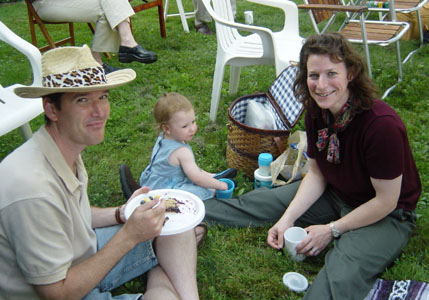 Welcome New Members!
Welcome New Members!
We are pleased to welcome Emily Franco and Jase Baese to the
club! Emily works a liason between the Statler and the Culinary
Institute of America, and Jase is a network administrator in the
horticulture department. They are restoring a stately manor on
Peruville Road, and are looking forward to developing the gardens. They
have an 18 month old daughter, Anna.
Topics for discussion...
Recently, a couple of issues have
be have come up with regards to club finances and activities. It is
crucial that all member have a voice in important decisions. If
you are unable to attend the meetings, please contact one of the board
members with your input.
1) Dues increase. TGOA/MGCOA has increased the annual dues from
$20 (individual)/$30 (family) to $30 (individual /$45
(family). Currently, our members pay the national dues + $10
local dues. That means that a 2006 membership will cost $40
(individual)/$55 (family). Such an increase may be a financial
hardship for some, and we do not want to lose valuable members.
To offset the increase, we are considering offering a few
“scholarships” that will be a private matter between the president,
treasurer, and the member. Down the line, we can evaluate the
benefits of membership in TGOA/MGOA. Deb Nero is a Regional
President, and can address/voice our concerns.
2) Seedlings. At the last meeting, concerns were raised about the
quality/variety of seedlings, and also the financial viability of the
IHS sale (see meeting minutes). According to Debi, almost every
personal request was met last year. We purchased most of our
seeds from Fedco because of pricing. Newer varieties (such as the
purple millet) may be purchased elsewhere, but will cost more.
The seedling list will be evaluated at the September meeting this
year. Please come ready to share your experiences with your LHBGC
seedlings. There will be a seedling questionnaire in the next
newsletter . Also, suggestions for new varieties to try are more than
welcome.
New Photos !
Photos from the picnic at Deb Nero's on
7/19/05 :

Relaxing on Deb's patio
|

Dave and Ginny Farmer (in their
Blueberry shirts!)
|

Gudy and Mike
|

Good food and chit-chat
|

Deb and her F1
|

Elke enjoys dessert
|

Mr. Louie
|

Ms. Anna
|

The beautiful view
(photo courtesy of Elke Schofield)
|

Elke and Helen
(photo courtesy of Elke Schofield) |
Additional photos of
Deb's beautiful garden
Opportunities
Upcoming
Horticultural Events
Adirondack Chapter of the North American
Rock Garden Society (NARGS) Member Plant Sale/Picnic - Aug.
20th, 2005. Bedlam Gardens, King Ferry, N.Y. They plant sale is
for members only, though folks are welcome to join at this meeting for
our 2005 membership year ($10). It's a great opportunity to bring in
rare and special plants or seedlings of limited quantity, knowing
they'll be given a good new home. You need not contribute plants to
participate. Come even if you're not in the market for more plants. Our
members are good cooks and Debi's gardens are inspirational.
10:00 a.m. – Arrive with plants (labeled beforehand) to price and set
up.
11:00 a.m. – Plant sale
12:00-ish – Lunch begins immediately following the sale. The Chapter
will provide beverages but you should bring a dish to pass, your own
table service and a lawn chair.
1:00 p.m. – Garden tour. After lunch, Debi will give a walking
tour through her extensive gardens.
Visit their website at http://elly.phpwebhosting.com/acnargs/gardens/
for more information.
Plants for Life Sale - Sept.
10th & 11th, at the Crescent under Scholkoff Field on the
Cornell University campus. Volunteers (plant experts, people to set up
and tear down, cashiers, and others) are needed to be on site
throughout the three days. Organizers will begin setting up for
the sale early on Sept. 9. The sale itself is scheduled for 10 a.m. to
3 p.m. Sept. 10 and 11. Volunteers are needed to help all three days at
the sale, which features thousands of desirable plants. So far,
thousands of native plants have been donated by more than 40 area
gardeners and nurseries throughout the region. Keep up-to-date with the
plants and other items to be sold by visiting http://www.ibca.net/plantsforlife/index.html.
The sale benefits the Ithaca Breast Cancer Alliance, a support
organization of breast cancer survivors. To volunteer or to find
out more information about the sale, e-mail plantsforlife@hotmail.com
or call Cindy Nicholson at 539-6923.
Southern Tier Iris Society Meeting
- Sept. 10th, 10 a.m. - 12 p.m. Vestal Public Library.
Program: Iris at the 2005 AIS Convention. Dorothy Stiefel and
Vaughn Sayles will provide an array of pictures of the iris in bloom in
the display gardens in St. Louis.
20th Annual CNY Tomatofest -
Sept. 10th & 11th, Emerson Park on Owasco Lake, Auburn,
NY. Visit http://www.cayuganet.org/tomatofest/
for directions and entertainment schedule.
TGOA/MGCOA Regional Meeting -
Saturday, Sept. 17th in Syracuse. Cost will probably be about $15.
Final details will come out later - Deb Nero will keep us posted.
If anyone is interested in going please call/email her (H:
607-539-7062, W: 607-254-4854, dn13@cornell.edu)
9th Annual Gathering of Gardeners
- Saturday, Sept. 24th, at the Rochester Museum & Science Center,
Rochester, NY. Featured lecturers are Sydney Eddison
and David Culp, Debi says it is well worth the $45 admission fee, and
the best part is visiting the vendors in the parking lot. Visit
the event website at http://gatheringofgardeners.com/
.
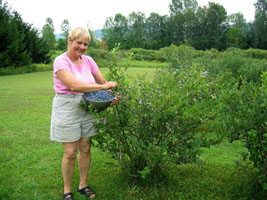 Still
time for blueberries! Visit Dave and Ginny Farmer's
website (http://www.farmerschoice.org/index.htm)
for berry updates, u-pick schedule, and yummy recipes. To the
right is a great picture of Elke at the Farmer Farm with her harvest!
Still
time for blueberries! Visit Dave and Ginny Farmer's
website (http://www.farmerschoice.org/index.htm)
for berry updates, u-pick schedule, and yummy recipes. To the
right is a great picture of Elke at the Farmer Farm with her harvest!
From Cornell Cooperative Extension
Dividing Bearded Irises and Other
Perennials - Wed, Aug. 10, 6-8 pm - August is the right
time to divide bearded and dwarf irises and some other perennials. Come
prepared to work at this hands-on workshop. We will tackle donated
clumps, but participants can also bring clumps from home to divide.
Rain or shine (indoors if wet). Fee: $5. Limited to 15 participants;
prepayment required. To register or for more information call 272-2292
or email klc39@cornell.edu.
Compost With Confidence - FREE
Outdoor Workshop Series -Last Saturday of every month (through
October), noon - 1 pm, Compost Demonstration Site at the Ithaca
Community Gardens (near the Farmers Market). In this free workshop
series, Master Composter volunteers will provide information and give
hands-on demonstrations to help you set up and manage a composting
system in any setting.
August 27 - Is it done? & Using Compost
September 24 - "Stealth" (double-bin, indoor system)
October 29 - Winter Composting
Treasurer’s Report
June 2005, Submitted by Elke Schofield on 7/19/05
INCOME
|
|
Membership 6/21/05
(Robert and Mary Jane Jacobson) |
$40.00 |
| EXPENSES |
|
Tower Rd. Greenhouse expenses
(4/1/05-6/30/05)
|
$204.40 |
Checking
account as of 6/30/05 =
|
$2,288.41 |
| Petty
Cash: |
$71.00 |
Meeting
Minutes
Liberty Hyde Bailey Garden Club
Annual Picnic
Garden of Debra Nero
National Lifelong Member
On this pleasant July evening, 17 members and guests gathered on the
lawn of Debra Nero to view the gardens and enjoy the delicious dishes
brought by those attending. Debbie led us on a tour of her
grounds which revealed an immense ant nest, a cool pond, an ancient
tree as well as raised flower beds.
In the absence of our President, Debbie led and informal open
discussion of topics of concern to members. Ray Fox raised
questions about the annual plant sale at Ithaca High School. Were
the quality and presentation of the seedlings a good reflection of
LHBGC abilities? Others commented on the sale and berm labor
which is borne by just a few senior members each year who may not be
able to continue such dedicated service. What other activities
should the club consider?
It was suggested that a committee be appointed to review the club
by-laws, draw up mission an vision statements, and make recommendations
for presentation to the membership for discussion and approval at a
future meeting. It would also be helpful for the program chair to
present an annual calendar of activities and speakers at the beginning
of each club year to carry out the approved mission and vision goals.
Members present agreed to give the matter of future club direction some
thought and to come to the next meeting with their suggestions for
further discussion. The president could then appoint a Review
Committee to draw up any by-law changes that may be necessary and to
prepare the mission and vision statements for presentation to the
membership for voting.
Our thanks to Debra for hosting and enjoyable evening.
Helen E. Swank
Recording Secretary
NOTE FROM DEB: I ended up with
an extra spoon after the picnic in July - it is tablespoon size and has
a purple handle. I'll bring it to the September meeting (I'm out
of town for the August meeting). Along those lines I seem to be missing
a serving spoon from my table ware set (I put them out with various
dishes that needed them). If someone has it can they please let me know
and bring it to the September meeting.
Articles:
Thanks to Ed Cobb for
forwarding this article to The
Baileyan. It was orginally published in the June 21st 2005
issue of the New York Times.
The Hobbit Garden can be visited online at
http://home.att.net/~hobbitgarden/
July 21, 2005
Cuttings;
A Lush Garden of
Delights, Eager to Share Its Secrets
A microcosm of conifers, bog
plants and winding paths concentrated on less than two acres.
By KEN DRUSE
Published: July 21, 2005
Raleigh, N.C.
FOR some
Southerners, gardening once meant venturing outdoors for two weeks in
March or April, when the azaleas bloomed, then dashing back inside an
air-conditioned house.
The gardens that
Willie Pilkington and John Edward Dilley built include a pond with
Japanese iris and carnivorous pitcher plants.
Willie Pilkington
and John Edward Dilley have defied the heat for 25 summers to create
two successive gardens that are so dense with unexpected plants, and so
inventive in their layout, that they have become a popular example of
how suburbia can be transformed.
Busloads of garden
lovers arrive to take tours of their property, and smaller groups make
appointments to see plants rarely available at local garden centers,
like dwarf conifers and carnivorous pitcher plants, and to learn from
the ingenious design, which turns a short walk into an adventure. "We
don't have a Longwood Gardens or Strybing Arboretum," Mr. Pilkington
said, referring to two of America's great public gardens. "There is a
real need for people to see what can grow here."
They did not set out
to create a public garden. In 1980, when they developed their original
landscape behind a 1921 bungalow here, their objective was to make the
most of a limited space and to satisfy an insatiable appetite for
plants.
That led to
imaginative design, with hedges separating disparate collections, and a
determination to test plants that they had seen and read about but that
were generally not available or grown in their area, like evergreens
that originate in much colder climates, or native ferns and bog plants.
"When we started we
turned to books for advice, but few, and certainly none of the English
books, had anything about what to plant in the South," Mr. Pilkington
said. "In England two days at 80 degrees is a heat wave."
Around the time they
were developing their first garden their friend J. C. Raulston, a
professor of horticulture at North Carolina State University, was also
testing new or untried varieties at the university's arboretum, which
was named for him after his death in 1996. But back in 1980, the men
were pretty much on their own. They scoured catalogs and made
prodigious lists of plants they liked and hoped to try.
During periodic
visits to Mr. Dilley's family farm in Blue Rock, Ohio - a state known
for its commercial growers of trees and shrubs - the men would spend a
good deal of their time touring nurseries. While hiking in the Great
Smoky Mountains and other natural areas in North Carolina, they
speculated that if certain plants thrived there, they and their cousins
might also grow in their backyard.
Their garden, which
measured only 50 by 80 feet, had more than a thousand species of bulbs,
ground covers, ferns, perennials, vines, shrubs and ornamental trees,
not to mention a vegetable garden, a greenhouse, a pergola and a stone
plaza. "We had secret paths, collections of dwarf plants and pools with
flowing water," said Mr. Dilley, who holds a degree in landscape
horticulture from Ohio State and is an urban planner. They named it the
Hobbit Garden.
From the start
curious neighbors would pause on the sidewalk, hoping to be invited in
for a closer look, and they always were.
The men didn't
intend to tempt fate when they selected needle-leaf evergreens that
originate in cool climates, like redwoods from coastal California and
spruces from snow-covered mountains. They just loved such conifers and
were particularly drawn to dwarf varieties. ("Dwarf" is a relative
term: these are compact, slow-growing versions of normal-size trees.)
It is Mr. Dilley's
contention that every garden should have theatrical moments, regardless
of its size. So narrow paths lead to openings that take visitors by
surprise. Many paths wind in tight "S" curves, with consecutive spaces
hidden from each other by evergreen screens.
"The curtain of
green foliage separated areas into subgardens, each with a unique
purpose and plant collection," Mr. Dilley said. You walk for a while,
through very detailed plantings, and do not realize that you are just
10 feet away from where you were moments earlier.
"Oddly enough, as
the islands of evergreens matured the property appeared to become much
larger and more intriguing," Mr. Dilley said.
But soon their own
plant lust and the rise in the numbers of visitors obliged them to find
a larger canvas. In 1995 they bought an acre and three-quarters on the
outskirts of Raleigh. The property, part of a farm that still operates
next door, had a brick ranch house and good sandy soil.
They put their first
house up for sale with the stipulation that the garden would leave with
them: they would have 30 days from the closing date to return at any
time to remove any shrub, tree, vine, bulb, rock or fish. Most of the
plants were dug up and placed in plastic nursery pots. The larger
shrubs and trees had their root balls swathed in burlap and tied.
The great migration
commenced in mid-December and continued through two weeks of
intermittent rain and snow.
"We'd arrive with
one load, take them off the truck and go right back for more," Mr.
Pilkington said.
A few of their new
neighbors brought food over to fortify them as they worked to develop
one part of the garden as quickly as possible: they were eager to show
that there was method to what might have seemed a summer of madness.
Nine months after
they had moved everything, Hurricane Fran arrived with 80-mile-an-hour
winds and 10 inches of rain. "We had just planted an 85-foot-long hedge
of Nellie Stevens holly to screen the road," Mr. Dilley said. After
months of cleanup and the replanting of the entire hedge, the garden
began anew in 1997.
Thus began Hobbit
Garden: The Sequel. The lessons from the original space were applied.
Paths were widened and evergreens of the same variety were massed to
present the appearance of larger, older specimens. And of course new
varieties are being added all the time.
"People come here
and see plants they've never seen before," Mr. Pilkington said. "One
man couldn't believe there was such a thing as an evergreen dogwood and
returned in winter to check for himself." It is quite likely that that
visitor, like Mr. Pilkington and Mr. Dilley, tracked the plant down at
a mail-order source or a specialty nursery and grows it in his garden
today.
I suppose one could
call gardening evangelical, when the primary objective is to spread the
good word. Mr. Pilkington and Mr. Dilley have dedicated their own
garden to sharing knowledge. That, and beauty.
To Every Clipping, There Is a Season
By KEN DRUSE
Published: July 21, 2005
IN creating the
miniature world of the Hobbit Garden, Willie Pilkington and John Edward
Dilley emulated the natural hierarchy of the woodlands. Ground covers
like golden Sedum makinoi Ogon and blue-flowered Laurentia fluviatilis
stand in for the forest floor, and the tallest trees, including a
Japanese maple and a Magnolia grandiflora, act as the canopy. The
middle layer is inhabited by compact conifers like Cedrus deodara,
shown at right, and small trees like Cornus kousa Wolf Eyes, a
spectacular variegated dogwood.
As in the woodlands,
nothing is wasted. The autumn leaves fall to the forest floor, where
they break down and return nutrition and humus to the soil. The leaves
also provide cover for over-wintering spring ephemerals like bloodroot,
trillium and Virginia bluebells, which will bloom before the tree
leaves emerge to form a shady canopy. Leaves are also raked, chopped
and used as mulch for planting beds. The mulch insulates the ground in
winter and summer, keeping roots moist and cool in the hot climate.
By composting
prunings and lawn clippings, the men never have to bag waste and haul
it to the curb. All the good stuff goes back into the garden.
Tours of the Hobbit
Garden are by appointment. Information: (919) 772-6761 or hobbitgarden@att.net.
KEN DRUSE
Helen
Swank provided a copy of a newsletter from the Brooklyn Botanic
Garden. It is full of interesting articles and tips, many of
which can be found on their website
http://www.bbg.org/
You can also sign up for their e-newsletter online.






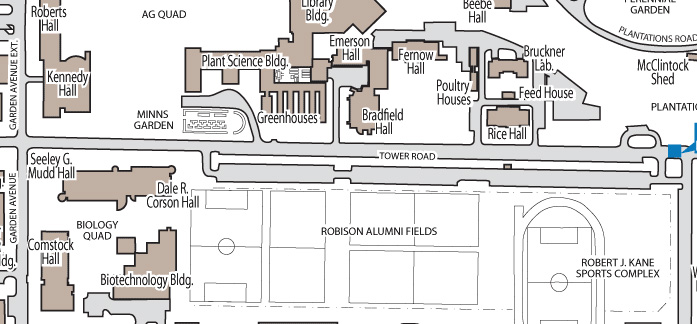

 Welcome New Members!
Welcome New Members! 









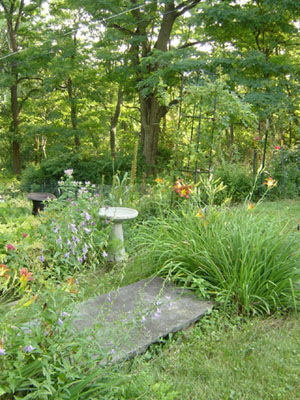
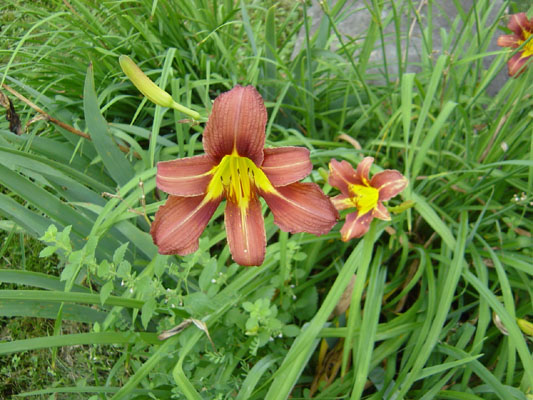
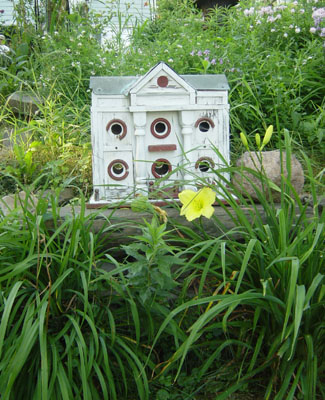
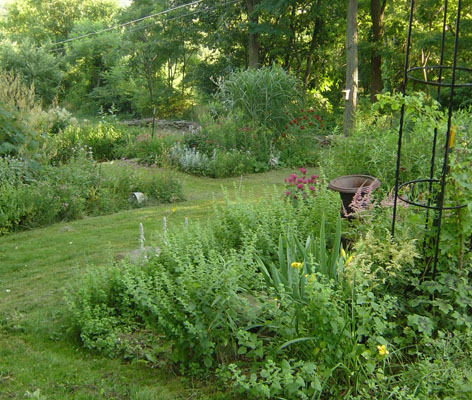
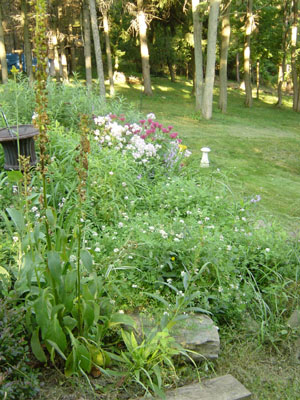
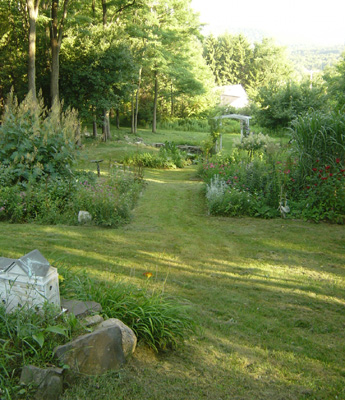
 Still
time for blueberries! Visit Dave and Ginny Farmer's
website (http://www.farmerschoice.org/index.htm)
for berry updates, u-pick schedule, and yummy recipes. To the
right is a great picture of Elke at the Farmer Farm with her harvest!
Still
time for blueberries! Visit Dave and Ginny Farmer's
website (http://www.farmerschoice.org/index.htm)
for berry updates, u-pick schedule, and yummy recipes. To the
right is a great picture of Elke at the Farmer Farm with her harvest!